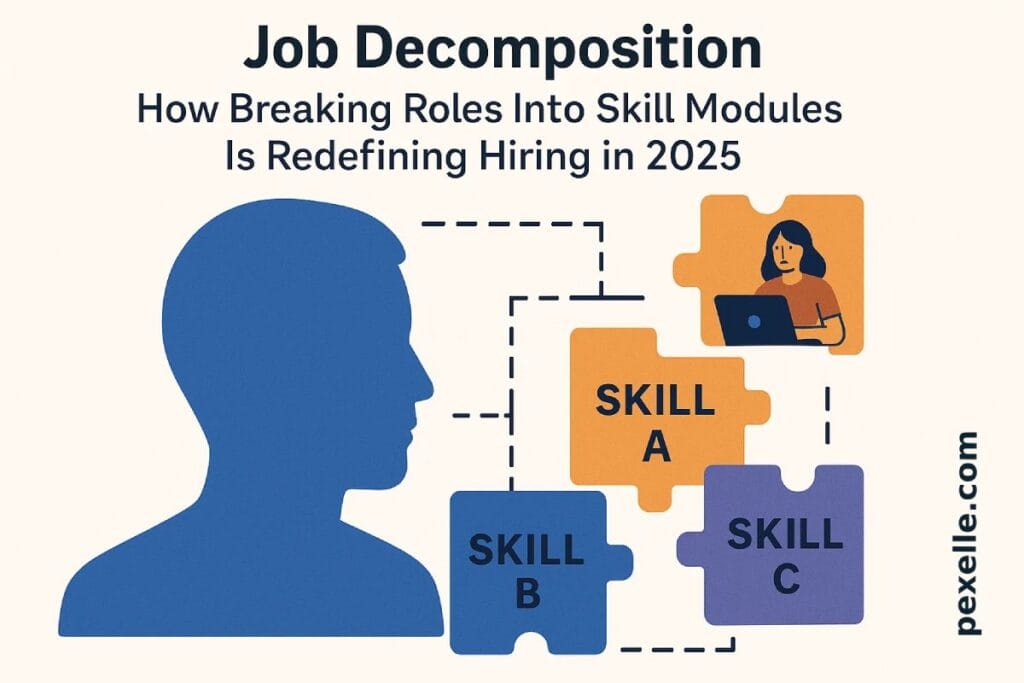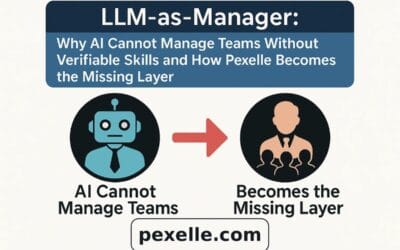Job Decomposition: How Breaking Roles Into Skill Modules Is Redefining Hiring in 2025

And how Pexelle builds accurate, evidence-based Skill Stacks for every modern job.
1. The End of “Job Titles” as a Hiring Signal
In 2025, hiring teams realized something obvious:
Job titles no longer mean anything.
- “Frontend Developer” can range from HTML beginner to React architect.
- “Data Analyst” may mean Excel user or expert-level ML operator.
- “Product Manager” can mean strategist or glorified note-taker.
Titles are too broad, too inconsistent, and too easy to inflate.
This led to a global movement in HR and AI:
Job Decomposition breaking roles into 20–40 concrete skill modules.
2. What Job Decomposition Actually Means
Job Decomposition converts a job into a Skill Stack, a structured set of:
- core skills
- micro-skills
- tools
- tasks
- required evidence
- proficiency levels
- dependencies between skills
Instead of saying:
“We need a Data Analyst.”
Companies now define:
- SQL (Intermediate)
- Query Optimization (Basic)
- Pandas (Intermediate)
- Data Cleaning (Advanced)
- Dashboarding (Power BI/Tableau)
- Business Storytelling
- Statistics Foundations
- Regression Modeling
- Data QA Practices
Each is a module measurable and verifiable.
3. Why Companies Are Shifting to Job Decomposition
Three reasons:
A) AI Recruiters Can’t Work With Job Titles
AI needs structured skills, not vague job labels.
B) Hiring Needs to Be Evidence-Based
Skill modules can be verified. Job titles cannot.
C) Talent Mobility Requires Standardization
People move between industries; standardized Skill Stacks allow them to map their experience without confusion.
Job Decomposition turns the messy world of job descriptions into machine-readable, fair, comparable skill frameworks.
4. Skill Stacks: The New Language of Work
A Skill Stack is a full decomposition of a job into layers:
Layer 1: Core Skills
The essential functional abilities (e.g., Backend Development, Data Analysis).
Layer 2: Applied Skills
Skills used in real tasks (e.g., API design, data visualization).
Layer 3: Micro-Skills
Precise, verifiable actions (e.g., writing SQL JOIN queries, handling pagination, cleaning datasets).
Layer 4: Tools & Tech
Frameworks, libraries, and environments.
Layer 5: Behavioral & Cognitive Skills
Problem-solving, communication, decision-making.
Layer 6: Evidence
Projects, code, tasks, output samples, evaluations.
Skill Stacks turn jobs into modular capability maps.
5. Why Job Decomposition Is Critical in 2025
Because hiring has fundamentally changed:
- AI systems rank candidates by skill, not CV text.
- Talent Cloud ecosystems require cross-border standardization.
- Up/reskilling needs modular learning paths.
- Teams want predictable capabilities.
- Job seekers want transparency about expectations.
Broken job titles are replaced by structured skill architecture.
6. How Pexelle Builds a Skill Stack for Any Job
Pexelle is designed to be the Skill Stack engine for modern hiring.
Here’s how:
✔ 1. Global Standards Alignment
Pexelle maps every job to international frameworks:
This gives each role a canonical structure.
✔ 2. Skill Graph Analysis
Instead of lists, Pexelle uses skill graphs to determine:
- dependencies
- related competencies
- required micro-skills
- typical project contexts
- skill progressions
The graph naturally forms the backbone of a job’s Skill Stack.
✔ 3. Decomposition Into Micro-Skills
For each role, Pexelle identifies 20–40 modules like:
- “Query optimization”
- “Component state management”
- “API integration testing”
- “Prompt evaluation”
- “Failure mode analysis”
Each micro-skill includes:
- definition
- difficulty
- evidence types
- expected output samples
- AI-evaluated test tasks
✔ 4. Project → Skill Mapping
Pexelle analyzes real projects from the user:
- code bases
- commits
- files
- task outputs
- datasets
- reports
Then maps them automatically into the appropriate modules.
This creates a true Skill Stack, not a theoretical one.
✔ 5. Scoring & Weighting
Pexelle scores every skill module based on:
- evidence quality
- recency
- frequency
- complexity
- project impact
- AI evaluation
This produces an accurate proficiency signal for each module.
✔ 6. Role-to-User Fit Analysis
With full Skill Stacks for both the job and the user, Pexelle’s AI computes:
- fit percentage
- missing modules
- strong modules
- suggested training
- recommended micro-skills to acquire
This is the backbone of autonomous job matching.
7. Real Example: Frontend Developer Skill Stack
A simplified decomposition might include:
Core Skills:
- JavaScript
- React
- TypeScript
Applied Skills:
- API integration
- Auth flows
- Performance optimization
Micro-Skills:
- writing custom hooks
- handling pagination
- debounce/throttle strategies
- state normalization
- accessibility testing
Evidence:
- production-level components
- pull requests
- demo apps
- UI test suites
Pexelle builds this automatically.
8. Why Job Decomposition Helps Both Employers and Talent
For Employers:
- reduced hiring risk
- standardized expectations
- AI-ready job definitions
- better internal mobility
- improved workforce planning
For Candidates:
- transparent skill gaps
- predictable growth path
- global recognition
- fair comparison
- proof-based hiring
It’s a win-win.
9. Job Decomposition + Pexelle = The Future of Hiring
By 2030:
- Job descriptions → Skill Stacks
- CVs → Skill Graphs
- Interviews → Evidence verification
- Job matching → Autonomous AI
- Credentials → On-chain proofs
- Career paths → Modular micro-skill tracks
Pexelle is the infrastructure enabling all of this by giving every job a decomposed, structured, evidence-ready Skill Stack.
10. Conclusion: Jobs Are Built From Skills And Pexelle Makes This Visible
Job Decomposition is not a trend it’s the new foundation of the global talent economy.
Roles are no longer titles.
They are collections of verifiable skill modules.
Pexelle turns those modules into Skill Stacks that AI can understand, employers can trust, and candidates can grow through.
This is the future of work modular, transparent, and evidence-driven.
Source : Medium.com




